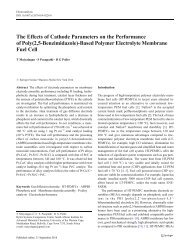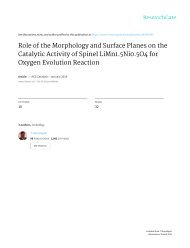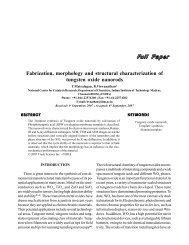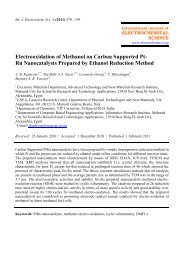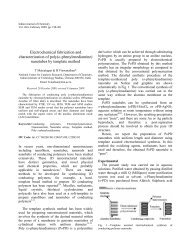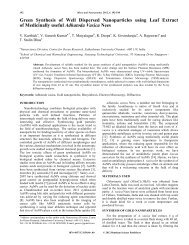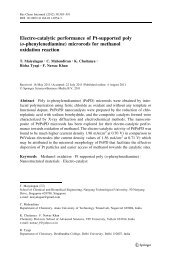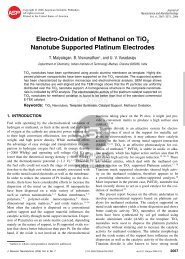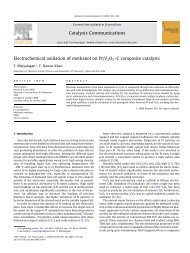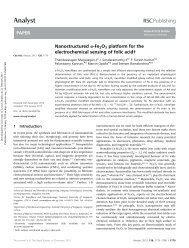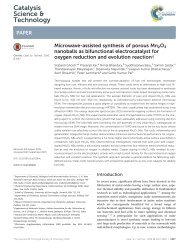Hierarchical 3-dimensional nickel–iron nanosheet arrays on carbon fiber paper as a novel electrode for non-enzymatic glucose sensing
You also want an ePaper? Increase the reach of your titles
YUMPU automatically turns print PDFs into web optimized ePapers that Google loves.
Nanoscale<br />
PAPER<br />
View Article Online<br />
View Journal<br />
Published <strong>on</strong> 18 November 2015. Downloaded by New York University <strong>on</strong> 21/11/2015 05:38:08.<br />
Cite this: DOI: 10.1039/c5nr06802a<br />
Received 1st October 2015,<br />
Accepted 26th October 2015<br />
DOI: 10.1039/c5nr06802a<br />
www.rsc.org/nanoscale<br />
<str<strong>on</strong>g>Hierarchical</str<strong>on</strong>g> 3-<str<strong>on</strong>g>dimensi<strong>on</strong>al</str<strong>on</strong>g> <str<strong>on</strong>g>nickel–ir<strong>on</strong></str<strong>on</strong>g> <str<strong>on</strong>g>nanosheet</str<strong>on</strong>g><br />
<str<strong>on</strong>g>arrays</str<strong>on</strong>g> <strong>on</strong> carb<strong>on</strong> <strong>fiber</strong> <strong>paper</strong> <strong>as</strong> a <strong>novel</strong> <strong>electrode</strong><br />
<strong>for</strong> n<strong>on</strong>-<strong>enzymatic</strong> <strong>glucose</strong> <strong>sensing</strong>†<br />
Palanisamy Kannan, a,c Thandavarayan Maiyalagan, b Enrico Marsili,* c Srabanti Ghosh, d<br />
Joanna Niedziolka-Jönss<strong>on</strong>* a and Martin Jönss<strong>on</strong>-Niedziolka* a<br />
Three-<str<strong>on</strong>g>dimensi<strong>on</strong>al</str<strong>on</strong>g> <str<strong>on</strong>g>nickel–ir<strong>on</strong></str<strong>on</strong>g> (3-D/Ni–Fe) nanostructures are exciting candidates <strong>for</strong> various applicati<strong>on</strong>s<br />
because they produce more reacti<strong>on</strong>-active sites than 1-D and 2-D nanostructured materials and<br />
exhibit attractive optical, electrical and catalytic properties. In this work, freestanding 3-D/Ni–Fe interc<strong>on</strong>nected<br />
hierarchical <str<strong>on</strong>g>nanosheet</str<strong>on</strong>g>s, hierarchical nanospheres, and porous nanospheres are directly grown<br />
<strong>on</strong> a flexible carb<strong>on</strong> <strong>fiber</strong> <strong>paper</strong> (CFP) substrate by a single-step hydrothermal process. Am<strong>on</strong>g the nanostructures,<br />
3-D/Ni–Fe interc<strong>on</strong>nected hierarchical <str<strong>on</strong>g>nanosheet</str<strong>on</strong>g>s show excellent electrochemical properties<br />
because of its high c<strong>on</strong>ductivity, large specific active surface area, and mesopores <strong>on</strong> its walls (vide infra).<br />
The 3-D/Ni–Fe hierarchical <str<strong>on</strong>g>nanosheet</str<strong>on</strong>g> array modified CFP substrate is further explored <strong>as</strong> a <strong>novel</strong> <strong>electrode</strong><br />
<strong>for</strong> electrochemical n<strong>on</strong>-<strong>enzymatic</strong> <strong>glucose</strong> sensor applicati<strong>on</strong>. The 3-D/Ni–Fe hierarchical<br />
<str<strong>on</strong>g>nanosheet</str<strong>on</strong>g> <str<strong>on</strong>g>arrays</str<strong>on</strong>g> exhibit significant catalytic activity towards the electrochemical oxidati<strong>on</strong> of <strong>glucose</strong>, <strong>as</strong><br />
compared to the 3-D/Ni–Fe hierarchical nanospheres, and porous nanospheres. The 3-D/Ni–Fe hierarchical<br />
<str<strong>on</strong>g>nanosheet</str<strong>on</strong>g> <str<strong>on</strong>g>arrays</str<strong>on</strong>g> can access a large amount of <strong>glucose</strong> molecules <strong>on</strong> their surface (mesopore walls)<br />
<strong>for</strong> an efficient electrocatalytic oxidati<strong>on</strong> process. Moreover, 3-D/Ni–Fe hierarchical <str<strong>on</strong>g>nanosheet</str<strong>on</strong>g> <str<strong>on</strong>g>arrays</str<strong>on</strong>g><br />
showed higher sensitivity (7.90 μA μM −1 cm −2 ) with wide linear <strong>glucose</strong> c<strong>on</strong>centrati<strong>on</strong> ranging from<br />
0.05 µM to 0.2 mM, and the low detecti<strong>on</strong> limit (LOD) of 0.031 µM (S/N = 3) is achieved by the amperometry<br />
method. Further, the 3-D/Ni–Fe hierarchical <str<strong>on</strong>g>nanosheet</str<strong>on</strong>g> array modified CFP <strong>electrode</strong> can be<br />
dem<strong>on</strong>strated to have excellent selectivity towards the detecti<strong>on</strong> of <strong>glucose</strong> in the presence of 500-fold<br />
excess of major important interferents. All these results indicate that 3-D/Ni–Fe hierarchical <str<strong>on</strong>g>nanosheet</str<strong>on</strong>g><br />
<str<strong>on</strong>g>arrays</str<strong>on</strong>g> are promising candidates <strong>for</strong> n<strong>on</strong>-<strong>enzymatic</strong> <strong>glucose</strong> <strong>sensing</strong>.<br />
1. Introducti<strong>on</strong><br />
<str<strong>on</strong>g>Hierarchical</str<strong>on</strong>g> nanostructures <strong>as</strong>sembled by low-<str<strong>on</strong>g>dimensi<strong>on</strong>al</str<strong>on</strong>g><br />
building blocks including nanoparticles, 1,2 nanorods, 3,4 and<br />
nanoplates 5,6 often exhibit significant morphology and/or size<br />
dependent properties. 7–11 C<strong>on</strong>sidered <strong>as</strong> an important functi<strong>on</strong>al<br />
nanomaterial, <str<strong>on</strong>g>nickel–ir<strong>on</strong></str<strong>on</strong>g> (Ni–Fe) nanostructures<br />
exhibit extraordinary electrical, catalytic, and magnetic<br />
a Institute of Physical Chemistry, Polish Academy of Sciences, 44/52 ul. K<strong>as</strong>przaka,<br />
01-224 Warsaw, Poland. E-mail: joaniek@ichf.edu.pl, martinj@ichf.edu.pl;<br />
Fax: +48223433333; Tel: +4822333433130<br />
b School of Chemistry, University of E<strong>as</strong>t Anglia, Norwich NR4 7TJ, UK<br />
c Singapore Centre <strong>on</strong> Envir<strong>on</strong>mental Life Sciences Engineering (SCELSE), Nanyang<br />
Technological University, 60 Nanyang Drive, SBS-01N-27, Singapore.<br />
E-mail: emarsili@ntu.edu.sg; Fax: +65-6515-6751; Tel: +65-6592-7895<br />
d Department of Chemical, Biological and Macromolecular Sciences, S. N. Bose<br />
Nati<strong>on</strong>al Centre <strong>for</strong> B<strong>as</strong>ic Sciences, Block-JD, Sector-III, Salt Lake, Kolkata-700098,<br />
India<br />
†Electr<strong>on</strong>ic supplementary in<strong>for</strong>mati<strong>on</strong> (ESI) available. See DOI: 10.1039/<br />
c5nr06802a<br />
properties and have potential technological applicati<strong>on</strong>s in<br />
electromagnetic shielding, absorbing materials, catalysis, and<br />
sensors. 10,12–14 Great attenti<strong>on</strong> h<strong>as</strong> been focused <strong>on</strong> the<br />
fabricati<strong>on</strong> of Ni–Fe micro-/nanostructures by using various<br />
physical and chemical methods. 10,15–18 For instance, low<br />
<str<strong>on</strong>g>dimensi<strong>on</strong>al</str<strong>on</strong>g> Ni–Fe nanostructures including nanochains 10<br />
and nanorods 15,19 have been synthesized by hydrothermal and<br />
calcinati<strong>on</strong> methods. Three <str<strong>on</strong>g>dimensi<strong>on</strong>al</str<strong>on</strong>g> (3-D) Ni–Fe nanostructures<br />
such <strong>as</strong> flowers, 18 dendrites, 20 and Ni–Fe layered<br />
double hydroxide films 8 have also been reported. The 3-D Ni–<br />
Fe hierarchical nanostructures are preferable <strong>for</strong> various technological<br />
applicati<strong>on</strong>s because they produce more reacti<strong>on</strong>active<br />
sites than 1-D and 2-D nanostructured materials and<br />
exhibit attractive optical, electr<strong>on</strong>ic, magnetic, and catalytic<br />
properties. 7,18<br />
The <strong>for</strong>mati<strong>on</strong> of hierarchical nanostructures is a self<strong>as</strong>sembly<br />
process, in which the ordered superstructures are<br />
<strong>for</strong>med by small building blocks, i.e., 0-D nanoparticles,<br />
1-<str<strong>on</strong>g>dimensi<strong>on</strong>al</str<strong>on</strong>g> nanorods or nanowires, and 2-D nanoflakes.<br />
21–23 Moreover, it is well known that templates and/or<br />
This journal is © The Royal Society of Chemistry 2015<br />
Nanoscale
View Article Online<br />
Paper<br />
Nanoscale<br />
Published <strong>on</strong> 18 November 2015. Downloaded by New York University <strong>on</strong> 21/11/2015 05:38:08.<br />
shape modifiers and c<strong>on</strong>trollers are usually used to prepare<br />
such hierarchical and complexed micro/nanostructures. 24,25 In<br />
additi<strong>on</strong>, hierarchically nanostructured materials have also<br />
been fabricated by physically c<strong>on</strong>strained crystal growth with<br />
the <strong>as</strong>sistance of templates, 26,27 which need to be completely<br />
removed after synthesis. Template-free methods, including<br />
soluti<strong>on</strong> ph<strong>as</strong>e reducti<strong>on</strong>, 28 chemical vapour depositi<strong>on</strong>, 29<br />
thermal decompositi<strong>on</strong>, 30 electrochemical depositi<strong>on</strong>, 31 and<br />
hydrothermal methods, 32 were widely explored to synthesize<br />
hierarchical nanostructured materials. Am<strong>on</strong>g them, the<br />
hydrothermal method h<strong>as</strong> received huge attenti<strong>on</strong> because of<br />
its simplicity, and suitability <strong>for</strong> large-scale producti<strong>on</strong>, which<br />
offers abundant c<strong>on</strong>trol parameters and can be used <strong>for</strong> <strong>electrode</strong><br />
modificati<strong>on</strong>s. Although different nanoarchitectures<br />
have been successfully prepared by the hydrothermal method<br />
(vide supra), we show that it is possible to directly grow 3-D<br />
Ni–Fe hierarchical <str<strong>on</strong>g>nanosheet</str<strong>on</strong>g> <str<strong>on</strong>g>arrays</str<strong>on</strong>g>, hierarchical nanospheres,<br />
and porous nanospheres through the hydrothermal process <strong>on</strong><br />
a flexible substrate.<br />
To accurately detect <strong>glucose</strong> is of immense scientific technological<br />
importance <strong>for</strong> clinical diagnostics in diabetes<br />
c<strong>on</strong>trol and analytical applicati<strong>on</strong>s in biotechnology, envir<strong>on</strong>mental<br />
polluti<strong>on</strong> c<strong>on</strong>trol, and the food industry. 33–37 Since<br />
enzyme b<strong>as</strong>ed amperometric sensors have significant drawbacks<br />
in stability because of the intrinsic nature of<br />
enzymes, 38–41 some methods have been developed to determine<br />
the <strong>glucose</strong> c<strong>on</strong>centrati<strong>on</strong> without using them. 42–46<br />
However, because of the surface pois<strong>on</strong>ing from the adsorbed<br />
intermediates and chloride, most of the n<strong>on</strong>-<strong>enzymatic</strong><br />
sensors have distinct problems with low sensitivity and poor<br />
selectivity. 47–49 Interferential effects from endogenous species<br />
including <strong>as</strong>corbic acid, uric acid, and dopamine cannot be<br />
totally eliminated. As a result, a major c<strong>on</strong>siderati<strong>on</strong> in practical<br />
n<strong>on</strong>-<strong>enzymatic</strong> <strong>glucose</strong> <strong>sensing</strong> is focused <strong>on</strong> fabricating<br />
high-per<strong>for</strong>mance devices using resourceful transiti<strong>on</strong>-metal<br />
catalysts. 50–59 Now, diabetes mellitus is a public health<br />
problem, and this metabolic disorder results from insulin<br />
deficiency and hyperglycemia and is reflected by blood <strong>glucose</strong><br />
c<strong>on</strong>centrati<strong>on</strong>s higher or lower than the normal range of<br />
80–120 mg dL −1 (4.4–6.6 mM). Good glycemic c<strong>on</strong>trol is the<br />
cornerst<strong>on</strong>e <strong>for</strong> proper diabetes management. Hence, it is pertinent<br />
to explore and develop n<strong>on</strong>-<strong>enzymatic</strong> sensors with a<br />
high sensitivity and a low detecti<strong>on</strong> limit to achieve c<strong>on</strong>vincing<br />
clinical me<strong>as</strong>urements.<br />
In this work, three-<str<strong>on</strong>g>dimensi<strong>on</strong>al</str<strong>on</strong>g> <str<strong>on</strong>g>nickel–ir<strong>on</strong></str<strong>on</strong>g> (3-D/Ni–Fe)<br />
interc<strong>on</strong>nected hierarchical <str<strong>on</strong>g>nanosheet</str<strong>on</strong>g>s, hierarchical nanospheres,<br />
and porous nanospheres are directly grown <strong>on</strong> flexible<br />
carb<strong>on</strong> <strong>fiber</strong> <strong>paper</strong> (CFP) collectors by a single-step hydrothermal<br />
process. Our approach utilizes small amounts of Fe<br />
metal <strong>as</strong> a doping agent <strong>for</strong> growing various morphologies. It<br />
is supposed that the ratio of urea and metal salts can <strong>as</strong>sist<br />
the <strong>for</strong>mati<strong>on</strong> of hierarchical nanostructures, which is c<strong>on</strong>firmed<br />
by the experimental results (vide infra). Further, we<br />
study the enzyme-free electrochemical <strong>sensing</strong> of <strong>glucose</strong> <strong>as</strong> a<br />
model system by using 3-D/Ni–Fe nanostructures. Interestingly,<br />
3-D/Ni–Fe hierarchical <str<strong>on</strong>g>nanosheet</str<strong>on</strong>g> <str<strong>on</strong>g>arrays</str<strong>on</strong>g> resulted in a remarkable<br />
enhancement in the electrocatalytic activity of <strong>glucose</strong> oxidati<strong>on</strong>,<br />
reusability, and stability because of its high<br />
c<strong>on</strong>ductivity, large specific surface area and mesopores <strong>on</strong> its<br />
walls. The 3-D/Ni–Fe hierarchical nanospheres and porous<br />
nanospheres were also tested under similar experimental c<strong>on</strong>diti<strong>on</strong>s<br />
used <strong>for</strong> comparing the electrochemical activity. The<br />
3-D/Ni–Fe hierarchical <str<strong>on</strong>g>nanosheet</str<strong>on</strong>g> <str<strong>on</strong>g>arrays</str<strong>on</strong>g> showed higher sensitivity<br />
(7.90 μA μM −1 cm −2 ) with wide linear resp<strong>on</strong>se of <strong>glucose</strong><br />
c<strong>on</strong>centrati<strong>on</strong> ranging from 0.05 µM to 0.2 mM, and the low<br />
detecti<strong>on</strong> limit (LOD) of 0.031 µM (S/N = 3) is achieved by the<br />
amperometry method. These results show the potential of<br />
these materials <strong>for</strong> use <strong>as</strong> <strong>electrode</strong>s <strong>for</strong> ultr<strong>as</strong>ensitive electrochemical<br />
experiments. We anticipate that they can be used in<br />
many different systems in the future.<br />
2. Experimental secti<strong>on</strong><br />
2.1. Materials<br />
FeCl 2·4H 2 O and Ni(NO 3 ) 2·6H 2 O, NaOH were obtained from<br />
Sigma-Aldrich Chemical Company. Urea (>99%) w<strong>as</strong> received<br />
from Merck Company. The nitric acid (HNO 3 ) soluti<strong>on</strong> w<strong>as</strong><br />
obtained from Aldrich Company. All other chemicals used in<br />
this investigati<strong>on</strong> were of analytical grade. All the soluti<strong>on</strong>s<br />
were prepared with Millipore water (18 mΩ) obtained from a<br />
Millipore system. Arg<strong>on</strong> (99.99%) w<strong>as</strong> supplied by Multax<br />
Company, Poland.<br />
2.2. Pre-treatment of CFP<br />
The CFP substrate w<strong>as</strong> w<strong>as</strong>hed repeatedly with 0.1 M HNO 3<br />
soluti<strong>on</strong>, and then subjected to 5 min ultra-s<strong>on</strong>icati<strong>on</strong> treatment<br />
in solvents such <strong>as</strong> acet<strong>on</strong>e, ethanol and water, respectively.<br />
Next, the CFP substrate w<strong>as</strong> rinsed with Millipore water,<br />
followed by drying with a stream of arg<strong>on</strong> g<strong>as</strong>. Finally, the<br />
above pre-treated CFP substrate w<strong>as</strong> used <strong>as</strong> collectors <strong>for</strong> preparing<br />
various morphologies of 3-D/Ni–Fe nanostructures.<br />
2.3. Synthesis of 3-D/Ni–Fe hierarchical <str<strong>on</strong>g>nanosheet</str<strong>on</strong>g> array<br />
nanostructures<br />
The typical synthesis of 3-D/Ni–Fe hierarchical <str<strong>on</strong>g>nanosheet</str<strong>on</strong>g><br />
<str<strong>on</strong>g>arrays</str<strong>on</strong>g> <strong>on</strong> carb<strong>on</strong> <strong>fiber</strong> <strong>paper</strong> can be explained <strong>as</strong> follows (optimized<br />
ratio <strong>as</strong> 2 : 1): 2 mM of FeCl 2·4H 2 O and 1 mM of<br />
Ni(NO 3 ) 2·6H 2 O were added to 20 mL of Millipore water, and<br />
then stirred <strong>for</strong> 15 min to obtain a homogeneous soluti<strong>on</strong>.<br />
Thereafter, 25 mM of urea w<strong>as</strong> added quickly to the reacti<strong>on</strong><br />
mixture, and then the reacti<strong>on</strong> mixture w<strong>as</strong> stirred again <strong>for</strong><br />
10 minutes; next, the above reacti<strong>on</strong> mixture w<strong>as</strong> transferred to<br />
a Tefl<strong>on</strong>-lined stainless steel autoclave vessel. Finally, the pretreated<br />
CFP substrate w<strong>as</strong> placed in the reacti<strong>on</strong> mixture, and<br />
then c<strong>on</strong>tinuously heated at 90° C <strong>for</strong> 6 h. After completi<strong>on</strong> of<br />
the reacti<strong>on</strong>, the CFP w<strong>as</strong> carefully removed from the reacti<strong>on</strong><br />
vessel, and then thoroughly w<strong>as</strong>hed with Millipore water, followed<br />
by drying at 40 °C <strong>for</strong> 8–12 h <strong>for</strong> further studies. The<br />
other 3-D/Ni–Fe nanostructures such <strong>as</strong> hierarchical nanospheres<br />
and porous nanospheres were obtained by repeating<br />
the above procedure by changing the Ni–Fe ratio to 1 : 1, and<br />
Nanoscale This journal is © The Royal Society of Chemistry 2015
View Article Online<br />
Nanoscale<br />
Paper<br />
Published <strong>on</strong> 18 November 2015. Downloaded by New York University <strong>on</strong> 21/11/2015 05:38:08.<br />
1 : 2, respectively. The m<strong>as</strong>s loading <strong>for</strong> all samples of Ni–Fe<br />
nanostructures <strong>on</strong> the CFP substrate w<strong>as</strong> calculated <strong>as</strong><br />
∼0.42 mg cm −2 . The 3-D/Ni–Fe hierarchical nanostructures<br />
grown over the CFP substrate can be used <strong>as</strong> a working<br />
<strong>electrode</strong> <strong>for</strong> electrochemical n<strong>on</strong>-<strong>enzymatic</strong> <strong>glucose</strong> sensor<br />
experiments.<br />
2.4. Instrumentati<strong>on</strong><br />
The morphologies of Ni–Fe nanostructures were characterized<br />
by field emissi<strong>on</strong>-scanning electr<strong>on</strong> microscopy (FE-SEM JEOL<br />
JSM-6700F). High-resoluti<strong>on</strong> transmissi<strong>on</strong> electr<strong>on</strong> microscopy<br />
(HRTEM) w<strong>as</strong> carried out using a JEOL JEM 3010 instrument<br />
with an accelerati<strong>on</strong> voltage of 200 kV. The samples were<br />
placed <strong>on</strong> a carb<strong>on</strong>-coated copper grid <strong>for</strong> morphology and<br />
size analyses. The crystallographic in<strong>for</strong>mati<strong>on</strong> w<strong>as</strong> obtained<br />
by the powder X-ray diffracti<strong>on</strong> technique (XRD, Shimadzu<br />
XRD-6000, Ni filtered CuKα (λ = 1.54 Å) radiati<strong>on</strong> operating at<br />
30 kV/40 mA). The specific surface area of the nanostructures<br />
w<strong>as</strong> determined using the cl<strong>as</strong>sic BET method (the Brunauer–<br />
Emmett–Teller isotherm). The BET isotherm is the b<strong>as</strong>is <strong>for</strong><br />
determining the extent of nitrogen adsorpti<strong>on</strong> <strong>on</strong> a given<br />
surface. XPS analysis w<strong>as</strong> per<strong>for</strong>med <strong>on</strong> a VG ESCALAB MK II<br />
with an Mg-Kα (1253.6 eV) achromatic X-ray source. Nitrogen<br />
adsorpti<strong>on</strong> data were collected using a Quantachrome autosorb<br />
automated g<strong>as</strong> sorpti<strong>on</strong> system. The electrochemical<br />
me<strong>as</strong>urements were per<strong>for</strong>med with a two compartment cell<br />
with a CFP (exposed geometric area = 0.16 cm 2 ), a Pt wire, and<br />
Ag/AgCl (3 M KCl) <strong>as</strong> the working, auxiliary and reference<br />
<strong>electrode</strong>s, respectively. Cyclic voltammograms were recorded<br />
using a computer c<strong>on</strong>trolled Autolab PGSTAT30 (Metrohm<br />
Autolab) electrochemical analyser. All electrochemical experiments<br />
were carried out under an arg<strong>on</strong> atmosphere.<br />
3. Results and discussi<strong>on</strong><br />
3.1 Synthesis and characterizati<strong>on</strong> of 3-D/Ni–Fe hierarchical<br />
nanostructures <strong>on</strong> CFP<br />
The 3-D/Ni–Fe hierarchical <str<strong>on</strong>g>nanosheet</str<strong>on</strong>g> <str<strong>on</strong>g>arrays</str<strong>on</strong>g> with high density<br />
could be e<strong>as</strong>ily grown <strong>on</strong> CFP by a facile and <strong>on</strong>e step hydrothermal<br />
route. The CFP w<strong>as</strong> chosen here because of its fine<br />
groove-like skelet<strong>on</strong> and high porosity, which helped to<br />
incre<strong>as</strong>e the active surface area of nanostructures. 60–62 The<br />
morphology of <strong>as</strong>-synthesized 3-D/Ni–Fe hierarchical<br />
<str<strong>on</strong>g>nanosheet</str<strong>on</strong>g> <str<strong>on</strong>g>arrays</str<strong>on</strong>g>/CFP w<strong>as</strong> characterized by the FE-SEM technique,<br />
<strong>as</strong> shown in Fig. 1. It can be seen that the smart 3-D/<br />
Ni–Fe hierarchical <str<strong>on</strong>g>nanosheet</str<strong>on</strong>g> <str<strong>on</strong>g>arrays</str<strong>on</strong>g> were quite uni<strong>for</strong>m,<br />
upright, outward, densely packed and well aligned, hierarchical<br />
wall-like <str<strong>on</strong>g>nanosheet</str<strong>on</strong>g>s grown <strong>on</strong> the surface of the CFP substrate<br />
and were ultrathin, which is favorable <strong>for</strong> the full<br />
utilizati<strong>on</strong> of active materials (Fig. 1A–D) <strong>for</strong> technological<br />
applicati<strong>on</strong>s. Such hierarchical wall-like <str<strong>on</strong>g>nanosheet</str<strong>on</strong>g>s were composed<br />
of several individual nano-walls with the lengths of 5–7<br />
µm (Fig. 1A). Each wall appeared to grow from the same<br />
origin/center of the CFP substrate. This indicates that the hierarchical<br />
wall-like 3-D/Ni–Fe bimetallic <str<strong>on</strong>g>nanosheet</str<strong>on</strong>g>s were successfully<br />
synthesized by the surfactant-free hydrothermal<br />
reducti<strong>on</strong> method. Interestingly, from the enlarged views<br />
Fig. 1 FE-SEM images of interc<strong>on</strong>nected hierarchical 3-D/Ni–Fe <str<strong>on</strong>g>nanosheet</str<strong>on</strong>g>s (A), and the corresp<strong>on</strong>ding different enlarged views (B, C), and close<br />
up view of a single <str<strong>on</strong>g>nanosheet</str<strong>on</strong>g> array showing the interc<strong>on</strong>nected nano “wall block” nanostructure (D).<br />
This journal is © The Royal Society of Chemistry 2015<br />
Nanoscale
View Article Online<br />
Paper<br />
Nanoscale<br />
Published <strong>on</strong> 18 November 2015. Downloaded by New York University <strong>on</strong> 21/11/2015 05:38:08.<br />
Fig. 2 FE-SEM images of extended views of interc<strong>on</strong>nected 3-D hierarchical <str<strong>on</strong>g>nanosheet</str<strong>on</strong>g>s (A), and view of mesopores in the <str<strong>on</strong>g>nanosheet</str<strong>on</strong>g>s (B), and<br />
photographs (C) of carb<strong>on</strong> <strong>fiber</strong> <strong>paper</strong> be<strong>for</strong>e (i) and after (ii) growing the Ni–Fe hierarchical <str<strong>on</strong>g>nanosheet</str<strong>on</strong>g> <str<strong>on</strong>g>arrays</str<strong>on</strong>g>.<br />
(Fig. 1B and C), the <str<strong>on</strong>g>nanosheet</str<strong>on</strong>g>s are interc<strong>on</strong>nected with each<br />
other to <strong>for</strong>m a wall-like nanostructure, which might possess<br />
better mechanical strength and durability. Further, these crystalline<br />
<str<strong>on</strong>g>nanosheet</str<strong>on</strong>g>s well-retained their hierarchical <str<strong>on</strong>g>nanosheet</str<strong>on</strong>g><br />
morphology without any calcinati<strong>on</strong>/annealing process. As<br />
shown in the high-magnificati<strong>on</strong> FE-SEM image (Fig. 1D), the<br />
interc<strong>on</strong>nected <str<strong>on</strong>g>nanosheet</str<strong>on</strong>g>s <strong>for</strong>m a highly open and mesoporous<br />
structure. Thus, a large specific (active) surface of 3-D/<br />
Ni–Fe hierarchical <str<strong>on</strong>g>nanosheet</str<strong>on</strong>g>s is highly accessible by the electrolyte/analyte<br />
when it is employed <strong>as</strong> an <strong>electrode</strong> material <strong>for</strong><br />
electrochemical <strong>sensing</strong>.<br />
It can be observed from Fig. 2 that in situ growth of hierarchical<br />
Ni–Fe <str<strong>on</strong>g>nanosheet</str<strong>on</strong>g> <str<strong>on</strong>g>arrays</str<strong>on</strong>g> resulted in 3-D interc<strong>on</strong>nected<br />
and oriented nanoarchitectures, the length is more than<br />
∼60 µm (Fig. 2A), which can help overcome the problem of low<br />
c<strong>on</strong>ductivity in c<strong>on</strong>venti<strong>on</strong>al <str<strong>on</strong>g>nanosheet</str<strong>on</strong>g> <str<strong>on</strong>g>arrays</str<strong>on</strong>g>. Further, it h<strong>as</strong><br />
already been pointed out that numerous 3-D/Ni–Fe hierarchical<br />
<str<strong>on</strong>g>nanosheet</str<strong>on</strong>g>s were grown uni<strong>for</strong>mly <strong>on</strong> the CFP surface.<br />
Importantly, wall-like 3-D/Ni–Fe hierarchical <str<strong>on</strong>g>nanosheet</str<strong>on</strong>g> <str<strong>on</strong>g>arrays</str<strong>on</strong>g><br />
cannot be destroyed into discrete walls even under ultr<strong>as</strong><strong>on</strong>icati<strong>on</strong><br />
<strong>for</strong> a l<strong>on</strong>g period of time (20 min), indicating that<br />
the complexed nanostructures are actually integrated and not<br />
made up of loosely grown nano-walls through magnetic dipole<br />
interacti<strong>on</strong>s. The 3-D/Ni–Fe hierarchical <str<strong>on</strong>g>nanosheet</str<strong>on</strong>g> <str<strong>on</strong>g>arrays</str<strong>on</strong>g> were<br />
synthesized using nickel nitrate and ir<strong>on</strong> chloride <strong>as</strong> metal<br />
sources and urea <strong>as</strong> the precipitant under hydrothermal c<strong>on</strong>diti<strong>on</strong>s<br />
at 90 °C (see the Experimental secti<strong>on</strong>). At this temperature,<br />
urea w<strong>as</strong> decomposed into amm<strong>on</strong>ia, the re<strong>as</strong><strong>on</strong> <strong>for</strong><br />
creating an alkaline envir<strong>on</strong>ment, and carb<strong>on</strong>ate, which served<br />
<strong>as</strong> an intercalated ani<strong>on</strong>. Now, Ni 2+ and Fe 3+ cati<strong>on</strong>s rele<strong>as</strong>ed<br />
from the reacti<strong>on</strong> mixture are simultaneously reduced to<br />
metallic atoms, and then sp<strong>on</strong>taneously <strong>for</strong>med 3-D/Ni–Fe<br />
bimetallic nanoparticle nuclei. The <strong>for</strong>med nuclei (Ni cati<strong>on</strong>s)<br />
occupy the center of the octahedral arrangement to grow into<br />
a small sheet-like structure, with OH − groups <strong>for</strong>ming the vertices<br />
of octahedra; then the octahedra share edges to <strong>for</strong>m<br />
two-<str<strong>on</strong>g>dimensi<strong>on</strong>al</str<strong>on</strong>g> sheets, which rely <strong>on</strong> the hydrogen b<strong>on</strong>ding<br />
between the hydroxyl groups of adjacent sheets. Next, the<br />
sheets can further grow three-<str<strong>on</strong>g>dimensi<strong>on</strong>al</str<strong>on</strong>g> network-like sheets<br />
by self-<strong>as</strong>sembly and then rec<strong>on</strong>structi<strong>on</strong> <strong>as</strong> well <strong>as</strong> a further<br />
growth step process. The grown hierarchical Ni–Fe <str<strong>on</strong>g>nanosheet</str<strong>on</strong>g>s<br />
characteristics will potentially exhibit superior per<strong>for</strong>mance in<br />
the electrochemical n<strong>on</strong>-<strong>enzymatic</strong> <strong>glucose</strong> sensor (see below).<br />
During the reacti<strong>on</strong>, the urea not <strong>on</strong>ly acts <strong>as</strong> the stabilizing or<br />
complexing regent but also plays a key role in the <strong>for</strong>mati<strong>on</strong> of<br />
the hierarchical morphology. Because of the urea, the<br />
<str<strong>on</strong>g>nanosheet</str<strong>on</strong>g>s becomes flexible, 63 and can be wrinkled and bent,<br />
which will help <str<strong>on</strong>g>nanosheet</str<strong>on</strong>g>s c<strong>on</strong>nect with each other and leads<br />
to the <strong>for</strong>mati<strong>on</strong> of ordered <str<strong>on</strong>g>arrays</str<strong>on</strong>g> (Scheme 1-1).<br />
The synergistic effect of Fe in the reacti<strong>on</strong> mixture also<br />
highly influences the <strong>for</strong>mati<strong>on</strong> of 3-D/Ni–Fe hierarchical<br />
<str<strong>on</strong>g>nanosheet</str<strong>on</strong>g> <str<strong>on</strong>g>arrays</str<strong>on</strong>g> under these c<strong>on</strong>diti<strong>on</strong>s, i.e., Fe acted <strong>as</strong> a<br />
nucleating agent inducing the reducti<strong>on</strong> of Ni at this (90 °C)<br />
reacti<strong>on</strong> temperature and <strong>as</strong>sists the <strong>for</strong>mati<strong>on</strong> of such hierarchical<br />
3-D/Ni–Fe nanostructures. As a result, sheet-like Ni–Fe<br />
hierarchical nanostructures <strong>for</strong>med, and simultaneously, rapid<br />
rele<strong>as</strong>e of water molecules during the c<strong>on</strong>versi<strong>on</strong> process<br />
resulted in the generati<strong>on</strong> of mesopores over the surface of<br />
<str<strong>on</strong>g>nanosheet</str<strong>on</strong>g>s (Fig. 2B), which resulted in the growth (in situ) of<br />
mesoporous 3-D/Ni–Fe hierarchical <str<strong>on</strong>g>nanosheet</str<strong>on</strong>g>s <strong>on</strong> the CFP<br />
surface (Scheme 1-1). The distance between <str<strong>on</strong>g>nanosheet</str<strong>on</strong>g>s w<strong>as</strong><br />
∼250 nm and the film thickness w<strong>as</strong> approximately 50–100 nm<br />
(Fig. 2B). To c<strong>on</strong>clude, a yellowish-brown film w<strong>as</strong> coated <strong>on</strong><br />
the surface of CFP (Fig. 2C, ii), indicating the successful<br />
Nanoscale This journal is © The Royal Society of Chemistry 2015
View Article Online<br />
Nanoscale<br />
Paper<br />
Published <strong>on</strong> 18 November 2015. Downloaded by New York University <strong>on</strong> 21/11/2015 05:38:08.<br />
Scheme 1 Schematic representati<strong>on</strong> of the <strong>for</strong>mati<strong>on</strong> of freestanding 3-D/Ni–Fe interc<strong>on</strong>nected hierarchical <str<strong>on</strong>g>nanosheet</str<strong>on</strong>g>s (1), hierarchical nanospheres<br />
(2), and porous nanospheres (3) <strong>on</strong> a flexible carb<strong>on</strong> <strong>fiber</strong> <strong>paper</strong> (CFP) substrate.<br />
growth of 3-D/Ni–Fe hierarchical <str<strong>on</strong>g>nanosheet</str<strong>on</strong>g> <str<strong>on</strong>g>arrays</str<strong>on</strong>g>. The m<strong>as</strong>ses<br />
of all the Ni–Fe nanostructures were determined by cutting the<br />
CFP with grown samples into smaller pieces with the diameter<br />
of 15 mm. Then CFP with grown samples and CFP were<br />
weighed with a high-precisi<strong>on</strong> analytical balance (Sartorius,<br />
max. weight 5100 mg, d = 0.001 mg) from which the exact<br />
m<strong>as</strong>s of the samples w<strong>as</strong> then determined. The loading<br />
density of the 3-D/Ni–Fe active material is calculated to be<br />
0.42 mg cm −2 (vide supra).<br />
Next we used the Ni–Fe ratio of 1 : 1 <strong>for</strong> preparati<strong>on</strong>; interestingly<br />
we observed that 3-D/Ni–Fe h<strong>as</strong> a hierarchical nanosphere<br />
morphology. The FE-SEM image obviously shows that<br />
the <strong>as</strong> prepared 3-D/Ni–Fe nanoparticles have a hierarchical<br />
nanospheres (flower-like) morphology (Fig. 3A and B). The particles<br />
are uni<strong>for</strong>m in size, ∼400 nm (Fig. 3B). The inset of<br />
Fig. 3B shows that the hierarchical nanospheres with a flowerlike<br />
architecture are <strong>as</strong>sembled by several interc<strong>on</strong>nected tiny<br />
sheet-like petals with a smooth surface and the thickness ca.<br />
150 nm. Such hierarchical nanosphere architectures follow a<br />
stepwise growth mechanism; at first, the generati<strong>on</strong> of tiny<br />
crystalline nanoparticle nuclei occurs in a reacti<strong>on</strong> mixture<br />
(vide infra) and subsequently, site-specific anisotropic growth<br />
occurred due to a n<strong>on</strong>-symmetrical <strong>as</strong>sembly process<br />
(Scheme 1-2). Then, the particles c<strong>on</strong>tinue to grow <strong>as</strong> striking<br />
hierarchical nanospheres (inset of Fig. 3B) with few nanoleaves<br />
sharing their originating center through coarsening,<br />
also known <strong>as</strong> Ostwald ripening (Scheme 1-2). 64,65<br />
On the other hand, <strong>for</strong> the Ni–Fe ratio of 1 : 2, the nanoparticle<br />
nuclei undergo random aggregati<strong>on</strong>, followed by<br />
growth of interc<strong>on</strong>nected porous nanosphere particles (Fig. 3A<br />
and B) due to nanoparticle-face attracti<strong>on</strong> through van der<br />
Waals <strong>for</strong>ces (Scheme 1-3). Further, CO 2 decomposed from<br />
CO(NH 2 ) 2 can also act <strong>as</strong> soft template to induce the verity of<br />
3-D/Ni–Fe nanostructure morphologies, since no other surfactant,<br />
templates and emulsi<strong>on</strong>s were used in this work (vide<br />
supra). As can be seen from the enlarged view (Fig. 3B and<br />
inset), the porous nanospheres were uni<strong>for</strong>m with a size of<br />
∼300 nm (Fig. 3B). Importantly, no calcinati<strong>on</strong> treatment<br />
process w<strong>as</strong> required in this work <strong>for</strong> preparing hierarchical Ni–<br />
Fe nanostructures. It should be noted here that this procedure<br />
establishes a universal protocol <strong>for</strong> the synthesis of 3-D/Ni–Fe<br />
hierarchical nanostructures without adopting different strategies,<br />
reacti<strong>on</strong> c<strong>on</strong>diti<strong>on</strong>s, or injecti<strong>on</strong> of <strong>for</strong>eign reagents<br />
(vide supra). Changing the ratio of the stabilizer and the pre-<br />
This journal is © The Royal Society of Chemistry 2015<br />
Nanoscale
View Article Online<br />
Paper<br />
Nanoscale<br />
Published <strong>on</strong> 18 November 2015. Downloaded by New York University <strong>on</strong> 21/11/2015 05:38:08.<br />
Fig. 3 FE-SEM images of hierarchical 3-D/Ni–Fe nanospheres (A), porous 3-D/Ni–Fe nanospheres (C) and the corresp<strong>on</strong>ding enlarged views (B, D),<br />
and insets showing the close up view of hierarchical nanosphere (B) and porous nanosphere (D) morphologies.<br />
cursor or vice versa resulted in the <strong>for</strong>mati<strong>on</strong> of 3-D/Ni–Fe<br />
nanostructures of different morphologies (Fig. S1 in the ESI†).<br />
The HRTEM images (Fig. 4; image A) show that the nanostructure<br />
of Ni–Fe grown <strong>on</strong> CFP is composed of a well-defined<br />
<str<strong>on</strong>g>nanosheet</str<strong>on</strong>g> morphology with the length of 1 μm; the Ni–Fe<br />
<str<strong>on</strong>g>nanosheet</str<strong>on</strong>g> offers abundant catalytic sites, which c<strong>on</strong>tributes to<br />
the high electrocatalytic activity of the composite material. The<br />
HRTEM image of the Ni–Fe hierarchical <str<strong>on</strong>g>nanosheet</str<strong>on</strong>g> (image B)<br />
shows mesoporous architectures. A large amount of well-distributed<br />
pores (<strong>on</strong> the surface) can be clearly seen, which is<br />
well-c<strong>on</strong>sistent with the results observed from FESEM. The<br />
hierarchical Ni–Fe <str<strong>on</strong>g>nanosheet</str<strong>on</strong>g> together with the mesoporous<br />
structure provides a large specific surface area, which w<strong>as</strong> estimated<br />
by the Brunauer–Emmett–Teller (BET) method 66 to be<br />
337.9 m 2 g −1 , much higher than those <strong>for</strong> hierarchical Ni–Fe<br />
nanospheres (211.3 m 2 g −1 ) and porous Ni–Fe nanospheres<br />
(136.4 m 2 g −1 ), respectively (Fig. S2†). The improved surface<br />
area allows <strong>for</strong> the rapid access of electrolyte i<strong>on</strong>s, provides<br />
abundant active sites <strong>for</strong> the electrocatalytic reacti<strong>on</strong>s, and<br />
facilitates f<strong>as</strong>t electr<strong>on</strong> transport between the <strong>electrode</strong><br />
materials and the analytes. The close up view of the HRTEM<br />
image (image C) clearly shows that the interplanar spacing of<br />
0.14 nm corresp<strong>on</strong>ds to the (111) crystalline plane. Further, a<br />
selected area electr<strong>on</strong> diffracti<strong>on</strong> (SAED) pattern analysis of<br />
hierarchical 3-D Ni–Fe <str<strong>on</strong>g>nanosheet</str<strong>on</strong>g>s showed several well-defined<br />
rings with discrete dots in the diffracti<strong>on</strong> pattern illustrating<br />
the crystalline nature of the sample (image D). This SAED<br />
diffracti<strong>on</strong> pattern w<strong>as</strong> well aligned with the XRD spectra,<br />
suggesting the crystalline nature of hierarchical Ni–Fe nanostructures.<br />
Next, the Ni–Fe hierarchical nanospheres grown <strong>on</strong><br />
CFP were composed of ultrathin nanoflakelets with a dimensi<strong>on</strong><br />
of ∼400 nm (image E), and close <strong>as</strong>semblies of Ni–Fe<br />
porous nanospheres (image F) with a size of ∼300 nm were<br />
further c<strong>on</strong>firmed by HRTEM analysis. The results obtained<br />
from HRTEM were highly c<strong>on</strong>sistent with the FESEM analysis.<br />
The ph<strong>as</strong>e structure and purity of the <strong>as</strong>-synthesized 3-D/<br />
Ni–Fe samples were examined by the XRD method. Fig. 5<br />
shows the XRD pattern of all Ni–Fe samples. It can be seen<br />
from Fig. 5 that all of the diffracti<strong>on</strong> peaks can be indexed to<br />
pure nanocrystalline structures. The XRD profile of the 3-D/Ni–<br />
Fe hierarchical <str<strong>on</strong>g>nanosheet</str<strong>on</strong>g> <str<strong>on</strong>g>arrays</str<strong>on</strong>g> (Fig. 5A), hierarchical nanospheres<br />
(Fig. 5B), and porous nanospheres (Fig. 5C) <strong>on</strong> the<br />
CFP substrate shows that the peaks at 43.1, 53.3, 62.7, 76.4,<br />
79.6, and 96.0 could be indexed <strong>as</strong> the (111), (200), (220),<br />
(311), (222), and (400) crystalline planes of the fcc (face centered-cubic)<br />
Ni ph<strong>as</strong>e (JCPDS No. 04-0850), respectively. 1,67–69<br />
The peak corresp<strong>on</strong>ding to the (111) plane is more intense<br />
than the other planes. The ratio between the intensities of the<br />
(200) and (111) diffracti<strong>on</strong> peaks is lower (0.51) than the usual<br />
value (0.60), suggesting that the (111) plane is the predominant<br />
orientati<strong>on</strong>. Interestingly the ratios of the relative peak<br />
intensities of the high index planes (311) and (222) are higher<br />
(0.62 versus 0.42) and (0.67 versus 0.55) than the standard<br />
values (dotted box in Fig. 5A). This observati<strong>on</strong> reveals that the<br />
3-D/Ni–Fe hierarchical <str<strong>on</strong>g>nanosheet</str<strong>on</strong>g>s were more abundant in<br />
high index facets than 3-D/Ni–Fe hierarchical nanospheres<br />
(Fig. 5B) and 3-D/Ni–Fe porous nanospheres (Fig. 5C). The<br />
absence of NiO peaks mainly at 37.2 and 44.3 corresp<strong>on</strong>ds to<br />
the (111) and (220) planes, indicating that no oxide product<br />
w<strong>as</strong> observed in the samples. Furthermore, the diffracti<strong>on</strong><br />
Nanoscale This journal is © The Royal Society of Chemistry 2015
View Article Online<br />
Nanoscale<br />
Paper<br />
Published <strong>on</strong> 18 November 2015. Downloaded by New York University <strong>on</strong> 21/11/2015 05:38:08.<br />
Fig. 4 High-resoluti<strong>on</strong> TEM images of hierarchical Ni–Fe <str<strong>on</strong>g>nanosheet</str<strong>on</strong>g>s with different magnificati<strong>on</strong>s (A–C), and the corresp<strong>on</strong>ding SAED pattern<br />
(image D). Images E and F represent hierarchical Ni–Fe nanospheres and porous Ni–Fe nanospheres, respectively.<br />
peaks at 35.4, 53.1 and 62.5 can be indexed <strong>as</strong> the (311), (511),<br />
and (440) planes corresp<strong>on</strong>ding to the Fe comp<strong>on</strong>ent in all the<br />
Ni–Fe nanostructures. 70 Their XRD patterns differ <strong>on</strong>ly in the<br />
relative intensities of given crystalline planes. The intensity of<br />
Fe peaks gets better (Fig. 5C) when the mole ratio 1 : 2 (Ni–Fe)<br />
is used <strong>for</strong> the synthesis of 3-D/Ni–Fe porous nanospheres<br />
rather than equal (Fig. 5B) or lower (Fig. 5A) mole ratios.<br />
It h<strong>as</strong> also been reported that the high c<strong>on</strong>centrati<strong>on</strong> of the<br />
Fe precursor (in the c<strong>as</strong>e of the 1 : 2 ratio) resulted in the <strong>for</strong>mati<strong>on</strong><br />
of oxide ph<strong>as</strong>es, 68 though in our synthetic protocol we<br />
have not observed any oxide ph<strong>as</strong>es. Except <strong>for</strong> Ni–Fe ph<strong>as</strong>es,<br />
the small broad diffracti<strong>on</strong> peak observed at 26.5 in<br />
Fig. 5(A–C) corresp<strong>on</strong>ds to the (002) plane of the graphitic<br />
carb<strong>on</strong> of the CFP substrate. 71 No additi<strong>on</strong>al peaks apart from<br />
the carb<strong>on</strong> <strong>fiber</strong> substrate were observed; this indicates that<br />
high-purity 3-D/Ni–Fe nanostructures were obtained during<br />
the synthesis. The str<strong>on</strong>g, sharp peaks and very low backgrounds<br />
reveal that the <strong>as</strong>-synthesized Ni–Fe bimetallic nanoparticles<br />
had a high degree of crystallinity (vide supra). As we<br />
discussed, Fe acted <strong>as</strong> a nucleating agent during the reacti<strong>on</strong><br />
and <strong>as</strong>sisted the <strong>for</strong>mati<strong>on</strong> of highly crystalline 3-D/Ni–Fe<br />
nanostructures.<br />
X-ray photoelectr<strong>on</strong> spectroscopy (XPS) is a powerful tool to<br />
identify the elements’ states in bulk material. 72 By the analysis<br />
of binding energy (BE) values, we have c<strong>on</strong>firmed the nature of<br />
Ni and Fe metals in the 3-D/Ni–Fe hierarchical nanostructures.<br />
Core-level high-resoluti<strong>on</strong> XPS spectra of Ni–Fe hierarchical<br />
<str<strong>on</strong>g>nanosheet</str<strong>on</strong>g>s exhibit two peaks present at 855.4 and 873.1 eV<br />
with a spin-energy separati<strong>on</strong> of 17.7 eV, corresp<strong>on</strong>ding to<br />
Ni 2p 3/2 and Ni 2p 1/2 , respectively (Fig. S3A†). 73 The binding<br />
energy of the Ni 2p 3/2 peaks is different from that in other<br />
reports of NiO (853.7 eV), NiS (853.1 eV) and Ni (852.6 eV), 74,75<br />
which reveals that the Ni exist in the <strong>for</strong>m of divalent. Next,<br />
the high-resoluti<strong>on</strong> Fe 2p spectrum (Fig. S3B†) shows two distinct<br />
peaks with binding energies of about 707.8 eV <strong>for</strong><br />
Fe 2p 3/2 and 722.4 eV <strong>for</strong> Fe 2p 1/2 . 76 The shakeup satellite peak<br />
present at ∼860–870 eV and ∼712–720 eV is characteristic of<br />
Ni 2+ and Fe 3+ i<strong>on</strong>s, respectively, in hierarchical Ni–Fe nanostructures.<br />
It also shows that the synthesized Ni–Fe nanostructures<br />
c<strong>on</strong>tain both Fe 3+ and Fe 2+ i<strong>on</strong>s, but it is obvious<br />
that the amount of Fe 3+ is higher than the amount of the Fe 2+<br />
i<strong>on</strong>s. Generally, the Fe 3+ and Fe 2+ i<strong>on</strong>s are found in its lattice<br />
due to its inverse spinel structure. The XPS result c<strong>on</strong>firms<br />
that the Fe exists <strong>as</strong> Fe 2+ /Fe 3+ and Ni <strong>as</strong> Ni 2+ in the prepared<br />
samples. The chemical compositi<strong>on</strong> (atomic percent) of the <strong>as</strong>prepared<br />
3-D/Ni–Fe hierarchical <str<strong>on</strong>g>nanosheet</str<strong>on</strong>g>s w<strong>as</strong> determined<br />
by energy-dispersive X-ray (EDX) spectrometry <strong>as</strong> shown in<br />
Fig. S3C.† The <strong>on</strong>ly detectable elements are ir<strong>on</strong>, nickel,<br />
carb<strong>on</strong>, and oxygen. While the carb<strong>on</strong> and oxygen should arise<br />
from the carb<strong>on</strong> <strong>fiber</strong> <strong>paper</strong>, and oxidati<strong>on</strong> from the surface of<br />
the samples, the corresp<strong>on</strong>ding elementary analysis reveals<br />
that the atomic ratio (%) of Ni to Fe is 63.3 : 31.2, which is very<br />
close to the initial set ratio of Fe : Ni = 2 : 1. The atomic ratios<br />
(%) of other morphologies such <strong>as</strong> 3-D/Ni–Fe hierarchical<br />
nanospheres and 3-D/Ni–Fe porous nanospheres were<br />
47.7 : 46.9% and 32.4 : 63.1%, respectively, which is c<strong>on</strong>sistent<br />
with their ratios 1 : 1 and 1 : 2. The above EDS results matched<br />
with the XRD pattern analysis, which revealed the crystallinity<br />
of the <strong>as</strong>-prepared hierarchical Ni–Fe nanostructures.<br />
3.2 Electrochemical behaviour of the 3-D/Ni–Fe hierarchical<br />
nanostructures <strong>on</strong> CFP <strong>electrode</strong><br />
To take advantage of its (3-D/Ni–Fe hierarchical <str<strong>on</strong>g>nanosheet</str<strong>on</strong>g><br />
<str<strong>on</strong>g>arrays</str<strong>on</strong>g>) mesopores and large specific (active) surface area<br />
This journal is © The Royal Society of Chemistry 2015<br />
Nanoscale
View Article Online<br />
Paper<br />
Nanoscale<br />
Published <strong>on</strong> 18 November 2015. Downloaded by New York University <strong>on</strong> 21/11/2015 05:38:08.<br />
Fig. 5 XRD patterns of <strong>as</strong>-synthesized 3-D/Ni–Fe hierarchical <str<strong>on</strong>g>nanosheet</str<strong>on</strong>g> (A), hierarchical Ni–Fe nanosphere (B), and porous Ni–Fe nanosphere (C)<br />
morphologies.<br />
(Fig. S2†), we decided to study enzyme-free electrochemical<br />
<strong>sensing</strong> of <strong>glucose</strong> <strong>as</strong> a model system. The electrocatalytic behavior<br />
of 3-D/Ni–Fe hierarchical nanostructures towards<br />
<strong>glucose</strong> oxidati<strong>on</strong> w<strong>as</strong> studied by cyclic voltammetry (CV) in<br />
0.1 M NaOH soluti<strong>on</strong>. As shown in Fig. 6A, a couple of sensitive<br />
redox peaks <strong>for</strong> the 3-D/Ni–Fe hierarchical <str<strong>on</strong>g>nanosheet</str<strong>on</strong>g> array<br />
CFP <strong>electrode</strong> is observed at potentials of 0.43 and 0.58 V<br />
(Fig. 6A, curve a), which could be mainly attributed to the<br />
Ni(II)/Ni(III) redox couple in alkaline medium. 77,78 It h<strong>as</strong> been<br />
known that when nickel is immersed in alkaline soluti<strong>on</strong>s,<br />
sp<strong>on</strong>taneous dissoluti<strong>on</strong> of the metal occurs followed by the<br />
<strong>for</strong>mati<strong>on</strong> of Ni(OH) 2 and finally NiOOH (eqn (1) and (2)). 79<br />
Ni þ 2OH<br />
Ni þ 2OH<br />
! NiO þ H 2 O þ 2e ðorÞ<br />
! NiðOHÞ 2<br />
þ 2e<br />
NiO þ OH ! NiOOH þ e ðorÞ<br />
ð2Þ<br />
NiðOHÞ 2<br />
þ OH $ NiOOH þ H 2 O þ e<br />
Furthermore, the electrochemical signal of the 3-D/Ni–Fe<br />
hierarchical <str<strong>on</strong>g>nanosheet</str<strong>on</strong>g> array CFP <strong>electrode</strong> is much larger<br />
than that of the bare CFP <strong>electrode</strong> (Fig. 6A, curve b),<br />
suggesting that the <strong>for</strong>mer <strong>electrode</strong> is highly suitable <strong>for</strong> electrochemical<br />
detecti<strong>on</strong>. Next, <strong>on</strong> the injecti<strong>on</strong> of 0.25 mM<br />
<strong>glucose</strong>, the sharp anodic peak current recorded from the<br />
3-D/Ni–Fe hierarchical <str<strong>on</strong>g>nanosheet</str<strong>on</strong>g> array CFP <strong>electrode</strong> is significantly<br />
higher than that from the same <strong>electrode</strong> without<br />
ð1Þ<br />
<strong>glucose</strong>. In additi<strong>on</strong>, the behaviour of the cathodic peak<br />
current is slightly incre<strong>as</strong>ed due to the <strong>glucose</strong> oxidati<strong>on</strong><br />
(Fig. 6A, curve c). These experimental results suggest the excellent<br />
electrocatalytic properties of 3-D/Ni–Fe hierarchical<br />
<str<strong>on</strong>g>nanosheet</str<strong>on</strong>g> <str<strong>on</strong>g>arrays</str<strong>on</strong>g> toward the oxidati<strong>on</strong> of <strong>glucose</strong>. The oxidati<strong>on</strong><br />
of <strong>glucose</strong> at the 3-D/Ni–Fe hierarchical <str<strong>on</strong>g>nanosheet</str<strong>on</strong>g> array<br />
CFP <strong>electrode</strong> w<strong>as</strong> electrocatalyzed by the NiO(OH)/Ni(OH) 2<br />
redox couple, according to the following reacti<strong>on</strong>s (eqn (3)<br />
and (4)): 80 NiðOHÞ 2<br />
þ OH $ NiOOH þ H 2 O þ e ð3Þ<br />
NiOOH þ <strong>glucose</strong> ! NiðOHÞ 2<br />
þ glucolact<strong>on</strong>e<br />
The significant incre<strong>as</strong>e of the anodic peak current c<strong>on</strong>tributes<br />
to the excellent electrocatalytic activity of Ni(OH) 2 in the<br />
3-D/Ni–Fe hierarchical <str<strong>on</strong>g>nanosheet</str<strong>on</strong>g> <str<strong>on</strong>g>arrays</str<strong>on</strong>g> <strong>on</strong> <strong>glucose</strong> oxidati<strong>on</strong>,<br />
which is accompanied by the oxidati<strong>on</strong> of Ni 2+ to Ni 3+ ,<strong>as</strong>in<br />
eqn (3). In additi<strong>on</strong>, because of the absorpti<strong>on</strong> of <strong>glucose</strong> and<br />
the oxidized intermediates <strong>on</strong> the active sites in mesopores of<br />
the 3-D/Ni–Fe hierarchical <str<strong>on</strong>g>nanosheet</str<strong>on</strong>g> array b<strong>as</strong>ed <strong>electrode</strong>,<br />
the anodic peak potential shifts to a little positive directi<strong>on</strong>. 81<br />
It is also <strong>as</strong>cribed to the diffusi<strong>on</strong> limitati<strong>on</strong> of <strong>glucose</strong> at the<br />
<strong>electrode</strong> surface; 67 these results are c<strong>on</strong>sistent with the previous<br />
Ni b<strong>as</strong>ed literature. 67,80,81<br />
Further, Fe acted <strong>as</strong> a synergistic catalyst to enhance the<br />
electrocatalytic oxidati<strong>on</strong> of <strong>glucose</strong> in the bimetallic Ni–Fe<br />
ð4Þ<br />
Nanoscale This journal is © The Royal Society of Chemistry 2015
View Article Online<br />
Nanoscale<br />
Paper<br />
Published <strong>on</strong> 18 November 2015. Downloaded by New York University <strong>on</strong> 21/11/2015 05:38:08.<br />
Fig. 6 (A) CVs of the 3-D/Ni–Fe hierarchical <str<strong>on</strong>g>nanosheet</str<strong>on</strong>g> array CFP <strong>electrode</strong> in 0.1 M NaOH soluti<strong>on</strong> with (a) and without (b) 0.25 mM <strong>glucose</strong>. The<br />
CVs obtained <strong>for</strong> the bare CFP <strong>electrode</strong> in 0.1 M NaOH c<strong>on</strong>taining 0.25 mM <strong>glucose</strong> <strong>for</strong> comparis<strong>on</strong> (c). (B) CVs of the 3-D/Ni–Fe hierarchical<br />
<str<strong>on</strong>g>nanosheet</str<strong>on</strong>g> array CFP <strong>electrode</strong> in a 0.1 M NaOH soluti<strong>on</strong> c<strong>on</strong>taining different c<strong>on</strong>centrati<strong>on</strong>s of <strong>glucose</strong>. The scan rate of 50 mV s −1 is used <strong>for</strong> the<br />
above (A) and (B) experiments. (C) CVs of the 3-D/Ni–Fe hierarchical <str<strong>on</strong>g>nanosheet</str<strong>on</strong>g> array CFP <strong>electrode</strong> in 0.25 mM <strong>glucose</strong> at various scan rates, and<br />
the inset shows plots of peak currents versus the square root of the scan rate. (D) CVs of 3-D/Ni–Fe hierarchical <str<strong>on</strong>g>nanosheet</str<strong>on</strong>g> array CFP (a), 3-D/Ni–Fe<br />
hierarchical nanosphere CFP (b), and 3-D/Ni–Fe porous nanosphere CFP (c) <strong>electrode</strong>s in 0.1 M NaOH soluti<strong>on</strong> c<strong>on</strong>taining 0.25 mM <strong>glucose</strong>.<br />
b<strong>as</strong>ed nanoparticle system. 1,2,8 Importantly, the incre<strong>as</strong>ed c<strong>on</strong>centrati<strong>on</strong><br />
of Fe c<strong>on</strong>tent in the bimetallic system h<strong>as</strong> incre<strong>as</strong>ed<br />
the overall electrocatalytic reacti<strong>on</strong> to some extent; 1,2,8 however<br />
in our c<strong>as</strong>e the morphology of Ni–Fe nanostructures h<strong>as</strong> also<br />
played an important role. We further c<strong>on</strong>ducted chr<strong>on</strong>oamperometric<br />
me<strong>as</strong>urements to evaluate the catalytic rate c<strong>on</strong>stant<br />
(k cat ); when the oxidati<strong>on</strong> current is dominated by the<br />
rate of the electrocatalytic reacti<strong>on</strong>, the catalytic current (I cat )<br />
can be written <strong>as</strong> eqn (5).<br />
I cat =I L ¼ π 1=2 ðk cat C 0 tÞ 1=2<br />
where I cat and I L are the currents in the presence and absence<br />
of <strong>glucose</strong>, respectively; k cat is the catalytic rate c<strong>on</strong>stant<br />
(M −1 s −1 ), C 0 the bulk c<strong>on</strong>centrati<strong>on</strong> (M) of <strong>glucose</strong>, and t the<br />
ð5Þ<br />
elapsed time (s). B<strong>as</strong>ed <strong>on</strong> the slope of I cat /I L vs. t 1/2 , the k cat<br />
value is calculated to be 1.80 × 10 3 M −1 s −1 taking the <strong>glucose</strong><br />
c<strong>on</strong>centrati<strong>on</strong> C 0 = 0.25 mM into account <strong>for</strong> the 3-D/Ni–Fe<br />
hierarchical <str<strong>on</strong>g>nanosheet</str<strong>on</strong>g> array CFP <strong>electrode</strong>, while the k cat<br />
obtained <strong>on</strong> the bare CFP <strong>electrode</strong> is calculated to be 0.31 ×<br />
10 3 M −1 s −1 . Fig. 6B displays the CVs of the 3-D/Ni–Fe hierarchical<br />
<str<strong>on</strong>g>nanosheet</str<strong>on</strong>g> array CFP <strong>electrode</strong> in 0.1 M NaOH c<strong>on</strong>taining<br />
different c<strong>on</strong>centrati<strong>on</strong>s of <strong>glucose</strong> (from 0.05 to 0.5 mM) at a<br />
scan rate of 50 mV s −1 . Up<strong>on</strong> successive additi<strong>on</strong>s of <strong>glucose</strong>, a<br />
remarkable current and potential incre<strong>as</strong>e of the anodic peak<br />
is obviously observed; this indicates that the 3-D/Ni–Fe hierarchical<br />
<str<strong>on</strong>g>nanosheet</str<strong>on</strong>g> array CFP <strong>electrode</strong> h<strong>as</strong> good sensitivity.<br />
Fig. 6C shows the effect of the scan rate <strong>on</strong> <strong>glucose</strong> oxidati<strong>on</strong><br />
at the 3-D/Ni–Fe hierarchical <str<strong>on</strong>g>nanosheet</str<strong>on</strong>g> array CFP <strong>electrode</strong> in<br />
0.1 M NaOH c<strong>on</strong>taining 0.25 mM <strong>glucose</strong>. It can be seen that<br />
This journal is © The Royal Society of Chemistry 2015<br />
Nanoscale
View Article Online<br />
Paper<br />
Nanoscale<br />
Published <strong>on</strong> 18 November 2015. Downloaded by New York University <strong>on</strong> 21/11/2015 05:38:08.<br />
the anodic peak shows a slightly positive shift, and the cathodic<br />
peak shifts negatively with the incre<strong>as</strong>e in scan rate. These<br />
results indicate that the redox reacti<strong>on</strong> of Ni(OH) 2 <strong>on</strong> the<br />
surface of carb<strong>on</strong> <strong>fiber</strong> is rapid and reversible. Moreover, the<br />
anodic peak potential shifts positively, suggesting that there is<br />
a kinetic limitati<strong>on</strong> in the reacti<strong>on</strong> of <strong>glucose</strong> oxidati<strong>on</strong>. 44 The<br />
inset of Fig. 6C shows that both anodic and cathodic peak currents<br />
from the 3-D/Ni–Fe hierarchical <str<strong>on</strong>g>nanosheet</str<strong>on</strong>g> array CFP<br />
<strong>electrode</strong> linearly scale with the square root of the scan rate,<br />
indicating that the redox reacti<strong>on</strong> of Ni(OH) 2 at the CFP<br />
surface is a typical diffusi<strong>on</strong>-c<strong>on</strong>trolled electrochemical<br />
process. 82 To compare the electrochemical per<strong>for</strong>mance of the<br />
3-D/Ni–Fe hierarchical <str<strong>on</strong>g>nanosheet</str<strong>on</strong>g> array b<strong>as</strong>ed CFP <strong>electrode</strong>,<br />
CVs of the 3-D/Ni–Fe hierarchical nanosphere CFP and 3-D/Ni–<br />
Fe porous nanosphere CFP <strong>electrode</strong>s were me<strong>as</strong>ured in 0.1 M<br />
NaOH electrolyte c<strong>on</strong>taining 0.25 mM <strong>glucose</strong> at a scan rate of<br />
50 mV s −1 , and the corresp<strong>on</strong>ding CV is shown in Fig. 6D. The<br />
CV analysis shows three peaks at 0.57, 0.60, and 0.62 V <strong>for</strong> 3-D/<br />
Ni–Fe interc<strong>on</strong>nected hierarchical <str<strong>on</strong>g>nanosheet</str<strong>on</strong>g>s, Ni–Fe nanospheres<br />
and porous Ni–Fe nanospheres, respectively. The 3-D/<br />
Ni–Fe interc<strong>on</strong>nected hierarchical <str<strong>on</strong>g>nanosheet</str<strong>on</strong>g>s show the lowest<br />
overpotential and the highest oxidati<strong>on</strong> current, 310 µA vs. 260<br />
and 230 µA <strong>for</strong> Ni–Fe nanospheres and porous Ni–Fe nanospheres,<br />
respectively. It can be seen that the 3-D/Ni–Fe hierarchical<br />
<str<strong>on</strong>g>nanosheet</str<strong>on</strong>g> array CFP <strong>electrode</strong> (Fig. 6D, curve a)<br />
showed enhanced electrocatalytic resp<strong>on</strong>se towards the oxidati<strong>on</strong><br />
of <strong>glucose</strong> in c<strong>on</strong>tr<strong>as</strong>t to the 3-D/Ni–Fe hierarchical<br />
nanosphere CFP (Fig. 6D, curve b), and 3-D/Ni–Fe porous<br />
nanosphere CFP (Fig. 6D, curve c) <strong>electrode</strong>s due to a large<br />
specific (active) surface area, and the interc<strong>on</strong>nected wall-like<br />
c<strong>on</strong>figurati<strong>on</strong> of <str<strong>on</strong>g>nanosheet</str<strong>on</strong>g>s provided an ideal plat<strong>for</strong>m <strong>for</strong><br />
accessing a large amount of <strong>glucose</strong> molecules. Overall, the<br />
observed higher electrocatalytic activity of 3-D/Ni–Fe hierarchical<br />
<str<strong>on</strong>g>nanosheet</str<strong>on</strong>g> <str<strong>on</strong>g>arrays</str<strong>on</strong>g> can be explained <strong>as</strong>: (i) the nanostructure<br />
of 3-D/Ni–Fe hierarchical <str<strong>on</strong>g>nanosheet</str<strong>on</strong>g> <str<strong>on</strong>g>arrays</str<strong>on</strong>g> offers a large<br />
specific (active) surface area; (ii) the interc<strong>on</strong>nected wall-like<br />
c<strong>on</strong>figurati<strong>on</strong> and good electr<strong>on</strong>ic c<strong>on</strong>ductivity of 3-D/Ni–Fe<br />
<str<strong>on</strong>g>nanosheet</str<strong>on</strong>g>s could support and provide reliable electrical c<strong>on</strong>necti<strong>on</strong>s<br />
towards the <strong>glucose</strong> molecules; (iii) their compatibility,<br />
i.e. 3-D/Ni–Fe <str<strong>on</strong>g>nanosheet</str<strong>on</strong>g>s can be directly grown <strong>on</strong> the<br />
current collector (CFP), makes them self-supporting nanostructures,<br />
(iv) 3-D/Ni–Fe hierarchical <str<strong>on</strong>g>nanosheet</str<strong>on</strong>g>s <strong>as</strong> active<br />
materials possess high electrochemical activity and c<strong>on</strong>tribute<br />
c<strong>on</strong>siderably compared to the other morphologies.<br />
3.3 Applicati<strong>on</strong> of the 3-D/Ni–Fe hierarchical <str<strong>on</strong>g>nanosheet</str<strong>on</strong>g> array<br />
CFP <strong>electrode</strong> in n<strong>on</strong>-<strong>enzymatic</strong> <strong>glucose</strong> <strong>sensing</strong><br />
The simple fabricati<strong>on</strong> procedure makes the <strong>as</strong>-prepared <strong>electrode</strong><br />
an effective plat<strong>for</strong>m <strong>for</strong> the amperometric determinati<strong>on</strong><br />
of <strong>glucose</strong>. C<strong>on</strong>sidering that the applied potential can<br />
str<strong>on</strong>gly affect the amperometric resp<strong>on</strong>se of biosensors, we<br />
have systemically investigated the impact of applied potential<br />
<strong>on</strong> the amperometric resp<strong>on</strong>se at the hierarchical 3-D/Ni–Fe<br />
<str<strong>on</strong>g>nanosheet</str<strong>on</strong>g> array CFP <strong>electrode</strong> to <strong>glucose</strong>. The results indicate<br />
that with the applied potential shifting from 0.60 to 0.70 V (in<br />
0.05 V steps), the steady-state current incre<strong>as</strong>es and reaches a<br />
maximum at 0.65 V; at the same time, applied potentials of<br />
0.60 and 0.70 V can also cause a notable enhancement of the<br />
current resp<strong>on</strong>se per additi<strong>on</strong> of <strong>glucose</strong>. Importantly, the<br />
smaller background current and lower noise observed at an<br />
optimized applied potential due to the <strong>glucose</strong> oxidati<strong>on</strong><br />
process w<strong>as</strong> efficiently completed at this potential, and thus<br />
the applied potential of 0.65 V w<strong>as</strong> selected <strong>for</strong> <strong>glucose</strong> detecti<strong>on</strong>.<br />
Fig. 7A shows the amperometric resp<strong>on</strong>se of the 3-D/Ni–<br />
Fe hierarchical <str<strong>on</strong>g>nanosheet</str<strong>on</strong>g> array CFP <strong>electrode</strong> towards the successive<br />
stepwise additi<strong>on</strong>s of <strong>glucose</strong> to a homogeneously<br />
stirred 0.1 M NaOH soluti<strong>on</strong> at a working potential of<br />
0.65 V. A steep incre<strong>as</strong>e in current resp<strong>on</strong>ses w<strong>as</strong> obtained<br />
after each additi<strong>on</strong> of 0.5 μM <strong>glucose</strong> soluti<strong>on</strong>, and a steadystate<br />
current w<strong>as</strong> achieved within 2 s, indicating that the 3-D/<br />
Ni–Fe hierarchical <str<strong>on</strong>g>nanosheet</str<strong>on</strong>g> array CFP <strong>electrode</strong> exhibits<br />
extremely sensitive and rapid resp<strong>on</strong>se characteristics. This<br />
might be due to the fact that 3-D interc<strong>on</strong>nected mesopores in<br />
the walls provide low resistance and promote electr<strong>on</strong> transfer<br />
to reduce the resp<strong>on</strong>se time. 67 The corresp<strong>on</strong>ding calibrati<strong>on</strong><br />
curve presented in Fig. 7B is linear over a c<strong>on</strong>centrati<strong>on</strong> range<br />
from 0.5 μM to 10.5 μM <strong>glucose</strong> with a correlati<strong>on</strong> coefficient<br />
of 0.9981. The sensitivity of the hierarchical 3-D/Ni–Fe<br />
<str<strong>on</strong>g>nanosheet</str<strong>on</strong>g> array CFP <strong>electrode</strong> is calculated to be<br />
7.90 μA μM −1 cm −2 . It w<strong>as</strong> further noted that the current<br />
resp<strong>on</strong>se incre<strong>as</strong>es accordingly when the c<strong>on</strong>centrati<strong>on</strong> of<br />
<strong>glucose</strong> c<strong>on</strong>tinuously incre<strong>as</strong>es up to 200 μM (Fig. 7C) with a<br />
correlati<strong>on</strong> coefficient of 0.9902 (Fig. 7D), indicating that all<br />
active sites of the 3-D/Ni–Fe hierarchical <str<strong>on</strong>g>nanosheet</str<strong>on</strong>g> array CFP<br />
<strong>electrode</strong> were highly sensitive at higher c<strong>on</strong>centrati<strong>on</strong> of<br />
<strong>glucose</strong>. B<strong>as</strong>ed <strong>on</strong> a signal-to-noise ratio of 3 (S/N = 3), the<br />
detecti<strong>on</strong> limit (LOD) w<strong>as</strong> 0.031 μM calculated from the standard<br />
deviati<strong>on</strong> of amperometric b<strong>as</strong>eline currents, suggesting<br />
the very good sensitivity of the 3-D/Ni–Fe hierarchical<br />
<str<strong>on</strong>g>nanosheet</str<strong>on</strong>g> array CFP <strong>electrode</strong>.<br />
In order to evaluate the per<strong>for</strong>mance of the sensor, a comparis<strong>on</strong><br />
of 3-D/Ni–Fe hierarchical nanosphere CFP and 3-D/<br />
Ni–Fe porous nanosphere CFP <strong>electrode</strong>s towards the n<strong>on</strong><strong>enzymatic</strong><br />
<strong>glucose</strong> sensor is shown in ESI Fig. S4A.† It can be<br />
observed that the sensitivities of 3-D/Ni–Fe hierarchical nanosphere<br />
CFP (curve a) and 3-D/Ni–Fe porous nanosphere<br />
(curve b) CFP <strong>electrode</strong>s were 3.10, and 2.60 μA μM −1 cm −2 ,<br />
respectively. We c<strong>on</strong>sider that the excellent electrocatalytic<br />
activity of the 3-D/Ni–Fe hierarchical <str<strong>on</strong>g>nanosheet</str<strong>on</strong>g> array CFP <strong>electrode</strong><br />
should be attributed to the fact that the 3-D interc<strong>on</strong>nected<br />
wall-like nanostructures with abundant mesopores<br />
and holes expanding from the surface to the bottom not <strong>on</strong>ly<br />
facilitate transport of <strong>glucose</strong> molecules through the electrolyte/<strong>electrode</strong><br />
interface, but also allow them to come into<br />
c<strong>on</strong>tact with more active surfaces (vide supra). Table S1† summarizes<br />
the n<strong>on</strong>-<strong>enzymatic</strong> <strong>glucose</strong> detecti<strong>on</strong> per<strong>for</strong>mance<br />
with different Ni- or Fe-b<strong>as</strong>ed <strong>electrode</strong>s reported so far. It can<br />
be c<strong>on</strong>cluded that our 3-D/Ni–Fe hierarchical <str<strong>on</strong>g>nanosheet</str<strong>on</strong>g> array<br />
CFP <strong>electrode</strong> possesses a higher sensitivity and a larger linear<br />
range toward <strong>glucose</strong> detecti<strong>on</strong>. These superiorities were<br />
attributed to the fact that the 3-D/Ni–Fe hierarchical <str<strong>on</strong>g>nanosheet</str<strong>on</strong>g><br />
<str<strong>on</strong>g>arrays</str<strong>on</strong>g> combined the synergistic effects from Fe, which results<br />
Nanoscale This journal is © The Royal Society of Chemistry 2015
View Article Online<br />
Nanoscale<br />
Paper<br />
Published <strong>on</strong> 18 November 2015. Downloaded by New York University <strong>on</strong> 21/11/2015 05:38:08.<br />
Fig. 7 Amperometric resp<strong>on</strong>se of the 3-D/Ni–Fe hierarchical <str<strong>on</strong>g>nanosheet</str<strong>on</strong>g> array CFP <strong>electrode</strong> at an applied potential of 0.65 V in 0.1 M NaOH with<br />
the dropwise additi<strong>on</strong> of 0.5 μM <strong>glucose</strong> (A), and the corresp<strong>on</strong>ding calibrati<strong>on</strong> plot of the obtained current resp<strong>on</strong>se vs. <strong>glucose</strong> c<strong>on</strong>centrati<strong>on</strong> (B).<br />
Typical amperometric resp<strong>on</strong>se of the 3-D/Ni–Fe hierarchical <str<strong>on</strong>g>nanosheet</str<strong>on</strong>g> array CFP <strong>electrode</strong> at 0.65 V with the successive additi<strong>on</strong>s of <strong>glucose</strong> up<br />
to 200 μM in 0.1 M NaOH (C) and the corresp<strong>on</strong>ding calibrati<strong>on</strong> plot of the obtained current resp<strong>on</strong>se vs. <strong>glucose</strong> c<strong>on</strong>centrati<strong>on</strong> (D).<br />
in high electrocatalytic activity and the electrical network<br />
<strong>for</strong>med directly <strong>on</strong> the CFP surface. Moreover, well dispersed<br />
Ni–Fe <str<strong>on</strong>g>nanosheet</str<strong>on</strong>g>s <strong>on</strong> the surface of CFP can favour the e<strong>as</strong>y<br />
access of <strong>glucose</strong> to <str<strong>on</strong>g>nanosheet</str<strong>on</strong>g>s, which significantly enhanced<br />
the electrochemical resp<strong>on</strong>se towards <strong>glucose</strong> oxidati<strong>on</strong>. We<br />
recorded the amperometric resp<strong>on</strong>ses of 0.5 μM <strong>glucose</strong> (steps<br />
a, b, g, k, l, and m), 250 μM of <strong>as</strong>corbic acid (AA, step c), dopamine<br />
(DA, step d), uric acid (UA, step e), acetaminophen (AP,<br />
step f), fructose (step h), galactose (step i), and lactose (step j)<br />
in homogeneously stirred 0.1 M NaOH soluti<strong>on</strong>, <strong>as</strong> shown in<br />
Fig. S4B.† It w<strong>as</strong> found that 3-D/Ni–Fe hierarchical <str<strong>on</strong>g>nanosheet</str<strong>on</strong>g><br />
<str<strong>on</strong>g>arrays</str<strong>on</strong>g> provide remarkable resp<strong>on</strong>ses <strong>on</strong>ly <strong>for</strong> <strong>glucose</strong><br />
oxidati<strong>on</strong>, and there is no obvious amperometric current<br />
resp<strong>on</strong>se <strong>for</strong> interfering species <strong>as</strong> compared to <strong>glucose</strong>, agreeing<br />
well with the Ni b<strong>as</strong>ed <strong>electrode</strong>s. 53,83<br />
In order to verify the reliability of the n<strong>on</strong>-<strong>enzymatic</strong><br />
<strong>glucose</strong> sensor <strong>for</strong> routine analysis, the sensor w<strong>as</strong> employed<br />
to determine <strong>glucose</strong> in blood serum samples. A commercial<br />
One-Touch Ultra glucometer (Johns<strong>on</strong> & Johns<strong>on</strong> Medical, Ltd)<br />
w<strong>as</strong> used <strong>as</strong> the standard tool to check the reliability in hospitals.<br />
In the current clinical practice, pl<strong>as</strong>ma rather than whole<br />
blood w<strong>as</strong> used to determine the c<strong>on</strong>centrati<strong>on</strong> of <strong>glucose</strong>. The<br />
levels of <strong>glucose</strong> in pl<strong>as</strong>ma are usually 10–15% higher than<br />
<strong>glucose</strong> in the whole blood. In other words, [<strong>glucose</strong>] blood =<br />
[<strong>glucose</strong>] pl<strong>as</strong>ma /1.14. 84 Through c<strong>on</strong>versi<strong>on</strong>, the results are<br />
listed in Tables S2 and S3.† It can be found that the values<br />
of <strong>glucose</strong> in human whole blood with the proposed <strong>sensing</strong><br />
<strong>electrode</strong> compared favourably to results obtained from the<br />
hospital. In general, the proposed method provided decre<strong>as</strong>ed<br />
analysis volume and an inexpensive and portable detecti<strong>on</strong><br />
plat<strong>for</strong>m. More importantly, it h<strong>as</strong> been shown to offer an<br />
accurate determinati<strong>on</strong> of <strong>glucose</strong> in real samples without any<br />
separati<strong>on</strong> procedure.<br />
4. C<strong>on</strong>clusi<strong>on</strong>s<br />
We dem<strong>on</strong>strated the direct growth of 3-D/Ni–Fe interc<strong>on</strong>nected<br />
hierarchical <str<strong>on</strong>g>nanosheet</str<strong>on</strong>g>s, hierarchical nanospheres, and<br />
porous nanospheres <strong>on</strong> a flexible CFP substrate by a singlestep<br />
hydrothermal process. Am<strong>on</strong>g the nanostructures, 3-D/<br />
Ni–Fe interc<strong>on</strong>nected hierarchical <str<strong>on</strong>g>nanosheet</str<strong>on</strong>g>s showed excellent<br />
electrochemical properties because of their high c<strong>on</strong>ductivity,<br />
large specific surface area and mesopores <strong>on</strong> their walls.<br />
The 3-D/Ni–Fe hierarchical <str<strong>on</strong>g>nanosheet</str<strong>on</strong>g> array modified CFP substrate<br />
w<strong>as</strong> successfully explored <strong>as</strong> a <strong>novel</strong> <strong>electrode</strong> <strong>for</strong> electrochemical<br />
n<strong>on</strong>-<strong>enzymatic</strong> <strong>glucose</strong> sensor applicati<strong>on</strong>. The 3-D/<br />
Ni–Fe hierarchical <str<strong>on</strong>g>nanosheet</str<strong>on</strong>g> <str<strong>on</strong>g>arrays</str<strong>on</strong>g> exhibit significant<br />
improvement in the electrochemical oxidati<strong>on</strong> of <strong>glucose</strong>,<br />
<strong>as</strong> compared to the 3-D/Ni–Fe hierarchical nanospheres, and<br />
porous nanospheres. Moreover, 3-D/Ni–Fe hierarchical<br />
<str<strong>on</strong>g>nanosheet</str<strong>on</strong>g> <str<strong>on</strong>g>arrays</str<strong>on</strong>g> possessed wide linear <strong>glucose</strong> c<strong>on</strong>centrati<strong>on</strong><br />
ranging from 0.05 µM to 200 µM, higher sensitivity<br />
This journal is © The Royal Society of Chemistry 2015<br />
Nanoscale
View Article Online<br />
Paper<br />
Nanoscale<br />
Published <strong>on</strong> 18 November 2015. Downloaded by New York University <strong>on</strong> 21/11/2015 05:38:08.<br />
(7.90 μA μM −1 cm −2 ) and the lowest detecti<strong>on</strong> limit (LOD) of<br />
0.031 µM (S/N = 3). Further, the 3-D/Ni–Fe hierarchical<br />
<str<strong>on</strong>g>nanosheet</str<strong>on</strong>g> array modified CFP <strong>electrode</strong> can be dem<strong>on</strong>strated<br />
to have excellent selectivity towards the detecti<strong>on</strong> of <strong>glucose</strong> in<br />
the presence of 500-fold excess of major important interferents.<br />
All these results indicate that 3-D/Ni–Fe hierarchical<br />
<str<strong>on</strong>g>nanosheet</str<strong>on</strong>g> <str<strong>on</strong>g>arrays</str<strong>on</strong>g> are a promising candidate <strong>for</strong> n<strong>on</strong>-<strong>enzymatic</strong><br />
<strong>glucose</strong> <strong>sensing</strong>.<br />
Acknowledgements<br />
Palanisamy Kannan thanks the NanOtechnology Biomaterials<br />
and aLternative Energy Source <strong>for</strong> ERA Integrati<strong>on</strong> [FP7-<br />
REGPOT-CT-2011-285949-NOBLESSE] project <strong>for</strong> financial<br />
support.<br />
References<br />
1 J. Li, W. Tang, H. Yang, Z. D<strong>on</strong>g, J. Huang, S. Li, J. Wang,<br />
J. Jin and J. Ma, RSC Adv., 2014, 4, 1988–1995.<br />
2 H. Yang, X. Zh<strong>on</strong>g, Z. D<strong>on</strong>g, J. Wang, J. Jin and J. Ma, RSC<br />
Adv., 2012, 2, 5038–5040.<br />
3 B. Nikoobakht, Z. L. Wang and M. A. El-Sayed, J. Phys.<br />
Chem. B, 2000, 104, 8635–8640.<br />
4 Z. Liu, S. W. Tay and X. Li, Chem. Commun., 2011, 47,<br />
12473–12475.<br />
5 F.-z. Mou, J.-g. Guan, Z.-g. Sun, X.-a. Fan and G.-x. T<strong>on</strong>g,<br />
J. Solid State Chem., 2010, 183, 736–743.<br />
6 Y. Leng, Y. Li, X. Li and S. Takah<strong>as</strong>hi, J. Phys. Chem. C,<br />
2007, 111, 6630–6633.<br />
7 K.-L. Wu, R. Yu and X.-W. Wei, CrystEngComm, 2012, 14,<br />
7626–7632.<br />
8 Z. Lu, W. Xu, W. Zhu, Q. Yang, X. Lei, J. Liu, Y. Li, X. Sun<br />
and X. Duan, Chem. Commun., 2014, 50, 6479–6482.<br />
9 G. T<strong>on</strong>g, J. Guan, Z. Xiao, F. Mou, W. Wang and G. Yan,<br />
Chem. Mater., 2008, 20, 3535–3539.<br />
10 J. Jia, J. C. Yu, Y.-X. J. Wang and K. M. Chan, ACS Appl.<br />
Mater. Interfaces, 2010, 2, 2579–2584.<br />
11 R. Ding, J. Liu, J. Jiang, J. Zhu and X. Huang, Anal.<br />
Methods, 2012, 4, 4003–4008.<br />
12 W. Zhou, L. He, R. Cheng, L. Guo, C. Chen and J. Wang,<br />
J. Phys. Chem. C, 2009, 113, 17355–17358.<br />
13 J. Li, W. Tang, J. Huang, J. Jin and J. Ma, Catal. Sci.<br />
Technol., 2013, 3, 3155–3162.<br />
14 H. Ma, Y. Huang, M. Shen, D. Hu, H. Yang, M. Zhu,<br />
S. Yang and X. Shi, RSC Adv., 2013, 3, 6455–6465.<br />
15 R. Suresh, K. Giribabu, R. Manigandan, A. Stephen and<br />
V. Narayanan, RSC Adv., 2014, 4, 17146–17155.<br />
16 N. Wang, M. Wen and Q. Wu, Colloids Surf., B, 2013, 111,<br />
726–731.<br />
17 J. Wang, Z. D<strong>on</strong>g, J. Huang, J. Li, X. Jin, J. Niu, J. Sun, J. Jin<br />
and J. Ma, Appl. Surf. Sci., 2013, 270, 128–132.<br />
18 L. Liu, J. Guan, W. Shi, Z. Sun and J. Zhao, J. Phys. Chem. C,<br />
2010, 114, 13565–13570.<br />
19 B. Singh, C.-L. Ho, Y.-C. Tseng and C.-T. Lo, J. Nanopart.<br />
Res., 2012, 14, 1–12.<br />
20 X.-M. Zhou and X.-W. Wei, Cryst. Growth Des., 2008, 9,<br />
7–12.<br />
21 H. Wang and A. L. Rogach, Chem. Mater., 2013, 26, 123–<br />
133.<br />
22 M. De Volder and A. J. Hart, Angew. Chem., Int. Ed., 2013,<br />
52, 2412–2425.<br />
23 Z. Ren, Y. Guo, C.-H. Liu and P.-X. Gao, Fr<strong>on</strong>t. Chem., 2013,<br />
1(18), 1–22.<br />
24 P. Gao, M. Zhang, H. Hou and Q. Xiao, Mater. Res. Bull.,<br />
2008, 43, 531–538.<br />
25 J. P. Xiao, Y. Xie, R. Tang, M. Chen and X. B. Tian, Adv.<br />
Mater., 2001, 13, 1887–1891.<br />
26 Q. Yang, T. Li, Z. Lu, X. Sun and J. Liu, Nanoscale, 2014, 6,<br />
11789.<br />
27 S. Cai, D. Zhang, L. Shi, J. Xu, L. Zhang, L. Huang, H. Li<br />
and J. Zhang, Nanoscale, 2014, 6, 7346–7353.<br />
28 X.-W. Wei, G.-X. Zhu, J.-H. Zhou and H.-Q. Sun, Mater.<br />
Chem. Phys., 2006, 100, 481–485.<br />
29 Z. W. Pan, Z. R. Dai and Z. L. Wang, Science, 2001, 291,<br />
1947–1949.<br />
30 D. Banerjee, J. Y. Lao, D. Z. Wang, J. Y. Huang, D. Steeves,<br />
B. Kimball and Z. F. Ren, Nanotechnol, 2004, 15, 404–<br />
409.<br />
31 B. Yang, Y. Wu, B. Z<strong>on</strong>g and Z. Shen, Nano Lett., 2002, 2,<br />
751–754.<br />
32 X. Zhang, A. Gu, G. Wang, Y. Huang, H. Ji and B. Fang,<br />
Analyst, 2011, 136, 5175–5180.<br />
33 J. Wang, Chem. Rev., 2007, 108, 814–825.<br />
34 A. Heller and B. Feldman, Chem. Rev., 2008, 108, 2482–<br />
2505.<br />
35 N. Mitro, P. A. Mak, L. Varg<strong>as</strong>, C. Godio, E. Hampt<strong>on</strong>,<br />
V. Molteni, A. Kreusch and E. Saez, Nature, 2007, 445, 219–<br />
223.<br />
36 J. Shi, H. Zhang, A. Snyder, M.-x. Wang, J. Xie, D. Marshall<br />
Porterfield and L. A. Stanciu, Biosens. Bioelectr<strong>on</strong>., 2012, 38,<br />
314–320.<br />
37 Y. Huang, X. D<strong>on</strong>g, Y. Shi, C. M. Li, L.-J. Li and P. Chen,<br />
Nanoscale, 2010, 2, 1485–1488.<br />
38 G. Rocchitta, O. Secchi, M. D. Alvau, D. Farina, G. Bazzu,<br />
G. Calia, R. Migheli, M. S. Desole, R. D. O’Neill and<br />
P. A. Serra, Anal. Chem., 2013, 85, 10282–10288.<br />
39 Y. S<strong>on</strong>g, K. Qu, C. Zhao, J. Ren and X. Qu, Adv. Mater.,<br />
2010, 22, 2206–2210.<br />
40 E. S. Forzani, H. Zhang, L. A. Nagahara, I. Amlani, R. Tsui<br />
and N. Tao, Nano Lett., 2004, 4, 1785–1788.<br />
41 M. D. Gouda, S. A. Singh, A. G. A. Rao, M. S. Thakur and<br />
N. G. Karanth, J. Biol. Chem., 2003, 278, 24324–24333.<br />
42 P. Subramanian, J. Niedziolka-J<strong>on</strong>ss<strong>on</strong>, A. Lesniewski,<br />
Q. Wang, M. Li, R. Boukherroub and S. Szunerits, J. Mater.<br />
Chem. A, 2014, 2, 5525–5533.<br />
43 C. Guo, H. Huo, X. Han, C. Xu and H. Li, Anal. Chem.,<br />
2013, 86, 876–883.<br />
44 X. Niu, M. Lan, H. Zhao and C. Chen, Anal. Chem., 2013,<br />
85, 3561–3569.<br />
Nanoscale This journal is © The Royal Society of Chemistry 2015
View Article Online<br />
Nanoscale<br />
Paper<br />
Published <strong>on</strong> 18 November 2015. Downloaded by New York University <strong>on</strong> 21/11/2015 05:38:08.<br />
45 X.-C. D<strong>on</strong>g, H. Xu, X.-W. Wang, Y.-X. Huang, M. B. Chan-<br />
Park, H. Zhang, L.-H. Wang, W. Huang and P. Chen, ACS<br />
Nano, 2012, 6, 3206–3213.<br />
46 H. Pang, Q. Lu, J. Wang, Y. Li and F. Gao, Chem. Commun.,<br />
2010, 46, 2010–2012.<br />
47 M. Shamsipur, M. Najafi and M.-R. M. Hosseini, Bioelectrochemistry,<br />
2010, 77, 120–124.<br />
48 J. Wang, D. F. Thom<strong>as</strong> and A. Chen, Anal. Chem., 2008, 80,<br />
997–1004.<br />
49 C. Li, Y. Liu, L. Li, Z. Du, S. Xu, M. Zhang, X. Yin and<br />
T. Wang, Talanta, 2008, 77, 455–459.<br />
50 Q. Chen, J. Wang, G. Rays<strong>on</strong>, B. Tian and Y. Lin, Anal.<br />
Chem., 1993, 65, 251–254.<br />
51 T. You, O. Niwa, Z. Chen, K. Hay<strong>as</strong>hi, M. Tomita and<br />
S. Hir<strong>on</strong>o, Anal. Chem., 2003, 75, 5191–5196.<br />
52 J. Chen, W.-D. Zhang and J.-S. Ye, Electrochem. Commun.,<br />
2008, 10, 1268–1271.<br />
53 L.-M. Lu, L. Zhang, F.-L. Qu, H.-X. Lu, X.-B. Zhang,<br />
Z.-S. Wu, S.-Y. Huan, Q.-A. Wang, G.-L. Shen and R.-Q. Yu,<br />
Biosens. Bioelectr<strong>on</strong>., 2009, 25, 218–223.<br />
54 C. Li, Y. Su, S. Zhang, X. Lv, H. Xia and Y. Wang, Biosens.<br />
Bioelectr<strong>on</strong>., 2010, 26, 903–907.<br />
55 Y. Liu, Y. Zhang, T. Wang, P. Qin, Q. Guo and H. Pang, RSC<br />
Adv., 2014, 4, 33514–33519.<br />
56 B. Zhan, C. Liu, H. Chen, H. Shi, L. Wang, P. Chen,<br />
W. Huang and X. D<strong>on</strong>g, Nanoscale, 2014, 6, 7424–7429.<br />
57 H. Liu, X. Lu, D. Xiao, M. Zhou, D. Xu, L. Sun and Y. S<strong>on</strong>g,<br />
Anal. Methods, 2013, 5, 6360–6367.<br />
58 C. Guo, X. Zhang, H. Huo, C. Xu and X. Han, Analyst, 2013,<br />
138, 6727–6731.<br />
59 D. Xiang, L. Yin, J. Ma, E. Guo, Q. Li, Z. Li and K. Liu,<br />
Analyst, 2015, 140, 644–653.<br />
60 D. K<strong>on</strong>g, H. Wang, Z. Lu and Y. Cui, J. Am. Chem. Soc.,<br />
2014, 136, 4897–4900.<br />
61 J. Xiao, L. Wan, S. Yang, F. Xiao and S. Wang, Nano Lett.,<br />
2014, 14, 831–838.<br />
62 L. Huang, D. Chen, Y. Ding, S. Feng, Z. L. Wang and<br />
M. Liu, Nano Lett., 2013, 13, 3135–3139.<br />
63 J. T. Sampanthar and H. C. Zeng, J. Am. Chem. Soc., 2002,<br />
124, 6668–6675.<br />
64 L.-P. Zhu, H.-M. Xiao, W.-D. Zhang, Y. Yang and S.-Y. Fu,<br />
Cryst. Growth Des., 2008, 8, 1113–1118.<br />
65 H. G. Yang and H. C. Zeng, J. Phys. Chem. B, 2004, 108,<br />
3492–3495.<br />
66 L. Seymour, E. S. Joan, A. T. Martin and T. Matthi<strong>as</strong>,<br />
Characterizati<strong>on</strong> of Porous Solids and Powders: Surface Area,<br />
Pore Size and Density, Particle Technology Series, Springer,<br />
Netherlands, 2004, 16, 1–350.<br />
67 H. Nie, Z. Yao, X. Zhou, Z. Yang and S. Huang, Biosens.<br />
Bioelectr<strong>on</strong>., 2011, 30, 28–34.<br />
68 Y. Chen, X. Luo, G.-H. Yue, X. Luo and D.-L. Peng, Mater.<br />
Chem. Phys., 2009, 113, 412–416.<br />
69 M. N. Islam, M. Abb<strong>as</strong> and C. Kim, Curr. Appl. Phys., 2013,<br />
13, 2010–2013.<br />
70 X. Teng and H. Yang, J. Mater. Chem., 2004, 14, 774–<br />
779.<br />
71 P. Kannan, T. Maiyalagan, N. G. Sahoo and M. Opallo,<br />
J. Mater. Chem. B, 2013, 1, 4655–4666.<br />
72 D. Yang, A. Velamakanni, G. Bozoklu, S. Park, M. Stoller,<br />
R. D. Piner, S. Stankovich, I. Jung, D. A. Field,<br />
C. A. Ventrice Jr. and R. S. Ruoff, Carb<strong>on</strong>, 2009, 47, 145–<br />
152.<br />
73 H. Yan, J. Bai, J. Wang, X. Zhang, B. Wang,<br />
Q. Liu and L. Liu, CrystEngComm, 2013, 15, 10007–<br />
10015.<br />
74 J. W. Lee, T. Ahn, D. Soundararajan, J. M. Ko and J.-D. Kim,<br />
Chem. Commun., 2011, 47, 6305–6307.<br />
75 H. W. Nesbitt, D. Legrand and G. M. Bancroft, Phys. Chem.<br />
Miner., 2000, 27, 357–366.<br />
76 N. Wang, M. Wen and Q. Wu, Colloids Surf., B, 2013, 111,<br />
726–731.<br />
77 Y. Zhang, F. Xu, Y. Sun, Y. Shi, Z. Wen and Z. Li, J. Mater.<br />
Chem., 2011, 21, 16949–16954.<br />
78 Y. Liu, H. Teng, H. Hou and T. You, Biosens. Bioelectr<strong>on</strong>.,<br />
2009, 24, 3329–3334.<br />
79 M. Giovanni, A. Ambrosi and M. Pumera, Chem. – Asian J.,<br />
2012, 7, 702–706.<br />
80 Y. Jiang, S. Yu, J. Li, L. Jia and C. Wang, Carb<strong>on</strong>, 2013, 63,<br />
367–375.<br />
81 L. Zheng, J.-q. Zhang and J.-f. S<strong>on</strong>g, Electrochim. Acta, 2009,<br />
54, 4559–4565.<br />
82 M. Tyagi, M. Tomar and V. Gupta, Biosens. Bioelectr<strong>on</strong>.,<br />
2014, 52, 196–201.<br />
83 S. Yu, X. Peng, G. Cao, M. Zhou, L. Qiao, J. Yao and H. He,<br />
Electrochim. Acta, 2012, 76, 512–517.<br />
84 R. Haeckel, U. Brinck, D. Colic, H.-U. Janka, I. Püntmann,<br />
J. Schneider and C. Viebrock, Clin. Chem., 2002, 48, 936–<br />
939.<br />
This journal is © The Royal Society of Chemistry 2015<br />
Nanoscale




